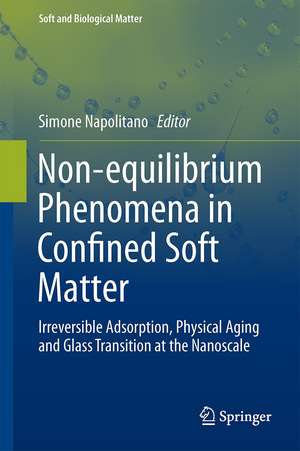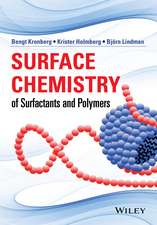Non-equilibrium Phenomena in Confined Soft Matter: Irreversible Adsorption, Physical Aging and Glass Transition at the Nanoscale: Soft and Biological Matter
Editat de Simone Napolitanoen Limba Engleză Hardback – 14 sep 2015
| Toate formatele și edițiile | Preț | Express |
|---|---|---|
| Paperback (1) | 561.24 lei 39-44 zile | |
| Springer International Publishing – 22 oct 2016 | 561.24 lei 39-44 zile | |
| Hardback (1) | 652.17 lei 3-5 săpt. | |
| Springer International Publishing – 14 sep 2015 | 652.17 lei 3-5 săpt. |
Din seria Soft and Biological Matter
- 18%
 Preț: 743.11 lei
Preț: 743.11 lei - 15%
 Preț: 642.18 lei
Preț: 642.18 lei -
 Preț: 372.11 lei
Preț: 372.11 lei -
 Preț: 389.70 lei
Preț: 389.70 lei - 15%
 Preț: 592.61 lei
Preț: 592.61 lei - 18%
 Preț: 1119.24 lei
Preț: 1119.24 lei - 15%
 Preț: 833.35 lei
Preț: 833.35 lei - 15%
 Preț: 656.89 lei
Preț: 656.89 lei - 20%
 Preț: 572.40 lei
Preț: 572.40 lei - 18%
 Preț: 1115.14 lei
Preț: 1115.14 lei - 18%
 Preț: 1012.46 lei
Preț: 1012.46 lei -
 Preț: 389.49 lei
Preț: 389.49 lei - 18%
 Preț: 943.77 lei
Preț: 943.77 lei - 18%
 Preț: 735.84 lei
Preț: 735.84 lei - 18%
 Preț: 789.52 lei
Preț: 789.52 lei - 18%
 Preț: 1010.17 lei
Preț: 1010.17 lei - 18%
 Preț: 952.09 lei
Preț: 952.09 lei
Preț: 652.17 lei
Preț vechi: 767.26 lei
-15% Nou
Puncte Express: 978
Preț estimativ în valută:
124.79€ • 130.04$ • 103.33£
124.79€ • 130.04$ • 103.33£
Carte disponibilă
Livrare economică 13-27 martie
Preluare comenzi: 021 569.72.76
Specificații
ISBN-13: 9783319219479
ISBN-10: 3319219472
Pagini: 300
Ilustrații: VIII, 300 p. 131 illus., 71 illus. in color.
Dimensiuni: 155 x 235 x 22 mm
Greutate: 0.74 kg
Ediția:1st ed. 2015
Editura: Springer International Publishing
Colecția Springer
Seria Soft and Biological Matter
Locul publicării:Cham, Switzerland
ISBN-10: 3319219472
Pagini: 300
Ilustrații: VIII, 300 p. 131 illus., 71 illus. in color.
Dimensiuni: 155 x 235 x 22 mm
Greutate: 0.74 kg
Ediția:1st ed. 2015
Editura: Springer International Publishing
Colecția Springer
Seria Soft and Biological Matter
Locul publicării:Cham, Switzerland
Public țintă
ResearchCuprins
From the Contents: Kinetics of irreversible chain adsorption, new insights from experiments and simulations.- Structure and dynamics of adsorbed polymer layers.- An investigation of irreversibly adsorbed polymer layers via Local Dielectric Spectroscopy.- History dependent temporal changes of properties of thin polymer films.
Notă biografică
Prof. Napolitano graduated in Materials Science from the University of Pisa in 2005 and two years after he received a PhD in Polymer Physics from KULeuven. After an appointment as postdoctoral researcher at the Research Foundation Flanders (FWO), in 2011 he joined the Université Libre de Bruxelles, where he holds a faculty position and leads the Laboratory of Polymers and Soft Matter Dynamics. His current research focuses on the molecular origin of the glass transition and the correlation between structure and dynamics in polymers and small molecules under nanoscopic confinement.
Textul de pe ultima copertă
This book presents cutting-edge experimental and computational results and provides comprehensive coverage on the impact of non-equilibrium structure and dynamics on the properties of soft matter confined to the nanoscale. The book is organized into three main sections:
· Equilibration and physical aging: by treating non-equilibrium phenomena with the formal methodology of statistical physics in bulk, the analysis of the kinetics of equilibration sheds new light on the physical origin of the non-equilibrium character of thin polymer films. Both the impact of sample preparation and that of interfacial interactions are analyzed using a large set of experiments. A historical overview of the investigation of the non-equilibrium character of thin polymer films is also presented. Furthermore, the discussion focuses on how interfaces and geometrical confinement perturb the pathways and kinetics of equilibrations of soft glasses (a process of tremendous technological interest).
· Irreversible adsorption: the formation of stable adsorbed layers occurs at timescales much larger than the time necessary to equilibrate soft matter in bulk. The question is posed as to whether this process could be considered as the driving force of equilibration. In this section, the investigation of the physics of irreversible chain adsorption is accompanied by a detailed analysis of the molecular dynamics, structure, morphology, and crystallization of adsorbed layers.
· Glass transition and material properties: the discussion covers a broad range of non-equilibrium phenomena affecting different families of soft materials – polymers, low molecular weight glass formers, and liquid crystals. In these systems, geometrical confinement induces the formation of non-equilibrium phases, otherwise not
achievable via processing of bulk samples. The examples illustrated in this section show how non-equilibrium phenomena can be exploited as innovative processing parameters to fabricate novel nanomaterials with improved performance. Finally, the differences between experiments performed under equilibrium conditions and temperature scans from equilibrium to non-equilibrium states at the nanoscale are discussed.
· Equilibration and physical aging: by treating non-equilibrium phenomena with the formal methodology of statistical physics in bulk, the analysis of the kinetics of equilibration sheds new light on the physical origin of the non-equilibrium character of thin polymer films. Both the impact of sample preparation and that of interfacial interactions are analyzed using a large set of experiments. A historical overview of the investigation of the non-equilibrium character of thin polymer films is also presented. Furthermore, the discussion focuses on how interfaces and geometrical confinement perturb the pathways and kinetics of equilibrations of soft glasses (a process of tremendous technological interest).
· Irreversible adsorption: the formation of stable adsorbed layers occurs at timescales much larger than the time necessary to equilibrate soft matter in bulk. The question is posed as to whether this process could be considered as the driving force of equilibration. In this section, the investigation of the physics of irreversible chain adsorption is accompanied by a detailed analysis of the molecular dynamics, structure, morphology, and crystallization of adsorbed layers.
· Glass transition and material properties: the discussion covers a broad range of non-equilibrium phenomena affecting different families of soft materials – polymers, low molecular weight glass formers, and liquid crystals. In these systems, geometrical confinement induces the formation of non-equilibrium phases, otherwise not
achievable via processing of bulk samples. The examples illustrated in this section show how non-equilibrium phenomena can be exploited as innovative processing parameters to fabricate novel nanomaterials with improved performance. Finally, the differences between experiments performed under equilibrium conditions and temperature scans from equilibrium to non-equilibrium states at the nanoscale are discussed.
Caracteristici
Presents the state of the art on the phenomena of nano-confinement for a large class of polymers and low molecular weight glass formers Shows how confinement effects are related to non-equilibrium phases Collects the latest and most important experiments and simulations on nanoconfined systems Features contributions from some of the most active and respected researchers in the field Includes supplementary material: sn.pub/extras







